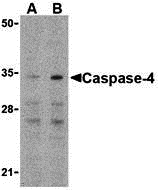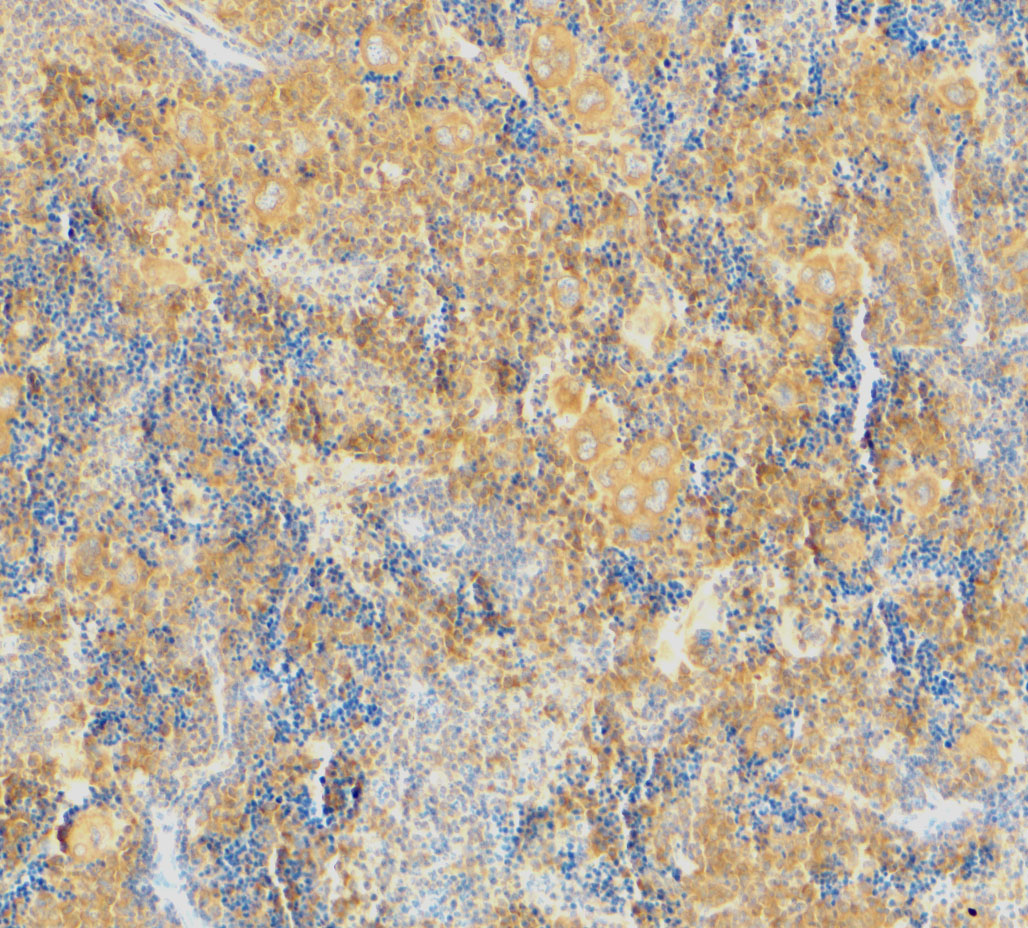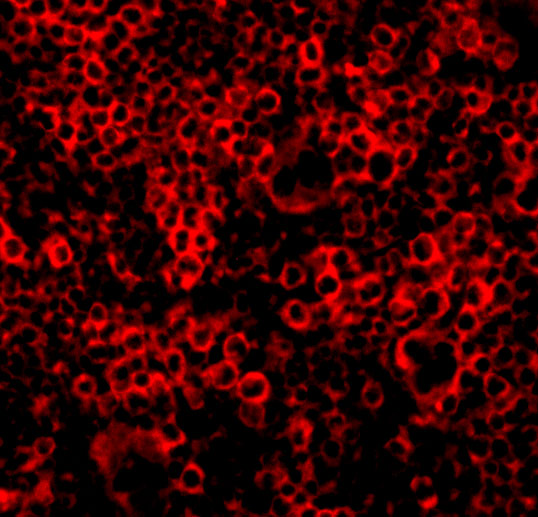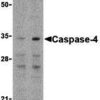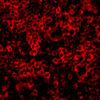Anti-Caspase-4 Antibody (11025)
$445.00
| Host | Quantity | Applications | Species Reactivity | Data Sheet | |
|---|---|---|---|---|---|
| Rabbit | 100ug | ELISA,WB,IHC-P,IF | Human, Mouse |  |
SKU: 11025
Categories: Antibody Products, Apoptosis Antibodies, Products
Overview
Product Name Anti-Caspase-4 Antibody (11025)
Description Anti-Caspase-4 Antibody Rabbit Polyclonal Antibody
Target Caspase-4
Species Reactivity Human, Mouse
Applications ELISA,WB,IHC-P,IF
Host Rabbit
Clonality Polyclonal
Isotype IgG
Immunogen Synthetic peptide corresponding to 16 amino acids at the amino-terminus of human Caspase-4 (accession no.
Properties
Form Liquid
Concentration Lot Specific
Formulation PBS, pH 7.4.
Buffer Formulation Phosphate Buffered Saline
Buffer pH pH 7.4
Format Purified
Purification Purified by peptide immuno-affinity chromatography
Specificity Information
Specificity This antibody recognizes human and mouse Caspase-4 (36kDa).
Target Name Caspase-4
Target ID Caspase-4
Uniprot ID P49662
Alternative Names CASP-4, EC 3.4.22.57, ICE and Ced-3 homolog 2, ICH-2, ICE(rel-II, Mih1, Protease TX [Cleaved into: Caspase-4 subunit p10; Caspase-4 subunit p20]
Gene Name CASP4
Gene ID 837
Accession Number NP_001216.1
Sequence Location Cytoplasm, cytosol, Endoplasmic reticulum membrane, Mitochondrion, Inflammasome, Secreted
Biological Function Inflammatory caspase that acts as an essential effector of the NLRP3 and NLRP6 inflammasomes by mediating lipopolysaccharide (LPS)-induced pyroptosis (PubMed:7797510, PubMed:23516580, PubMed:26375003, PubMed:32109412). Thiol protease that cleaves a tetrapeptide after an Asp residue at position P1: catalyzes cleavage of CGAS, GSDMD and IL18 (PubMed:7797510, PubMed:15326478, PubMed:23516580, PubMed:26375003, PubMed:28314590, PubMed:32109412). Required for innate immunity to cytosolic, but not vacuolar, bacteria (By similarity). Plays a key role in NLRP3-dependent CASP1 activation and IL1B and IL18 secretion in response to non-canonical activators, such as UVB radiation, cholera enterotoxin subunit B and cytosolic LPS (PubMed:26508369, PubMed:22246630, PubMed:23516580, PubMed:24879791, PubMed:25119034, PubMed:26173988, PubMed:26174085, PubMed:25964352). Activated by direct binding to LPS without the need of an upstream sensor (PubMed:25119034). Involved in NLRP6 inflammasome-dependent activation in response to lipoteichoic acid (LTA), a cell-wall component of Gram-positive bacteria, which leads to CASP1 activation and IL1B and IL18 secretion (PubMed:33377178). Independently of NLRP3 inflammasome and CASP1, promotes pyroptosis, through GSDMD cleavage and activation, followed by IL1A, IL18 and HMGB1 release in response to non-canonical inflammasome activators (PubMed:26375003, PubMed:32109412). Plays a crucial role in the restriction of Salmonella typhimurium replication in colonic epithelial cells during infection: in later stages of the infection, LPS from cytosolic Salmonella triggers CASP4 activation, which catalyzes cleavage of GSDMD, resulting in pyroptosis of infected cells and their extrusion into the gut lumen, as well as in IL18 secretion (PubMed:25121752, PubMed:26375003, PubMed:25964352, PubMed:34671164, PubMed:32109412). Cleavage of GSDMD is not strictly dependent on the consensus cleavage site but depends on an exosite interface on CASP4 that rUniProtKB:P70343, PubMed:15123740, PubMed:15326478, PubMed:22246630, PubMed:23516580, PubMed:23661706, PubMed:24879791, PubMed:25119034, PubMed:25121752, PubMed:25964352, PubMed:26173988, PubMed:26174085, PubMed:26375003, PubMed:26508369, PubMed:28314590, PubMed:32109412, PubMed:33377178, PubMed:34671164, PubMed:7743998, PubMed:7797510, PubMed:7797592}.; (Microbial infection) In response to the Td92 surface protein of the periodontal pathogen T.denticola, activated by cathepsin CTSG which leads to production and secretion of IL1A and pyroptosis of gingival fibroblasts. {PubMed:29077095}.
Research Areas Apoptosis
Background Caspases are a family of cysteine proteases. Caspase-4 was initially identified as a homologous protein to Caspase-1 and the C. elegans Ced-3 which could induce apoptosis in transfected cells. More recent studies have shown that it can be activated by ER stress and has been suggested to be involved in multiple neuronal pathologies such as Alzheimer's disease.
Application Images




Description Western blot analysis of caspase-4 in Ramos cells with caspase-4 antibody at (A) 0.5 and (B) 1 ug/mL.

Description Immunohistochemical staining of mouse spleen using caspase-4 antibody at 2 ug/mL.

Description Immunofluorescence of Caspase-4 in Mouse Spleen 100 cells with Caspase-4 antibody at ug/mL.
Handling
Storage This antibody is stable for at least one (1) year at -20°C. Avoid multiple freeze-thaw cycles.
Dilution Instructions Dilute in PBS or medium which is identical to that used in the assay system.
Application Instructions Immunoblotting: use at 1ug/mL.
Positive control: Ramos cell lysate.
Immunohistochemistry: use at 2ug/mL.
These are recommended concentrations.
Enduser should determine optimal concentrations for their applications.
Positive control: Ramos cell lysate.
Immunohistochemistry: use at 2ug/mL.
These are recommended concentrations.
Enduser should determine optimal concentrations for their applications.
References & Data Sheet
Data Sheet  Download PDF Data Sheet
Download PDF Data Sheet
 Download PDF Data Sheet
Download PDF Data Sheet

